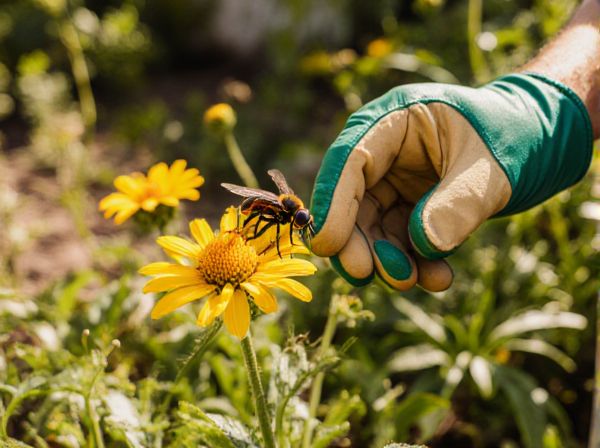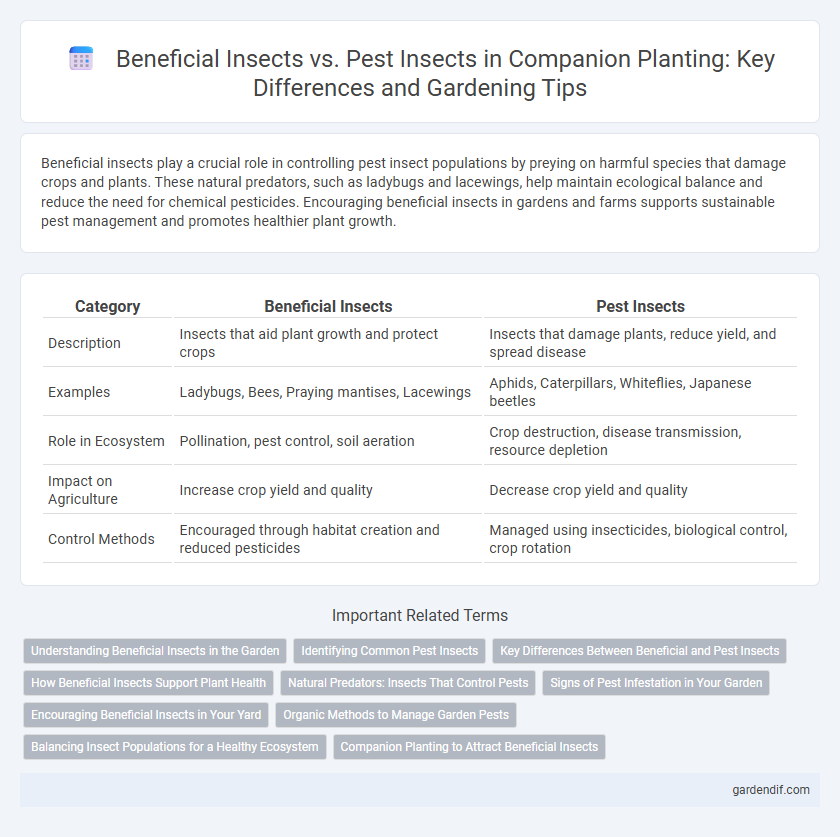
Beneficial insects vs pest insects Illustration
Beneficial insects play a crucial role in controlling pest insect populations by preying on harmful species that damage crops and plants. These natural predators, such as ladybugs and lacewings, help maintain ecological balance and reduce the need for chemical pesticides. Encouraging beneficial insects in gardens and farms supports sustainable pest management and promotes healthier plant growth.
Table of Comparison
| Category | Beneficial Insects | Pest Insects |
|---|---|---|
| Description | Insects that aid plant growth and protect crops | Insects that damage plants, reduce yield, and spread disease |
| Examples | Ladybugs, Bees, Praying mantises, Lacewings | Aphids, Caterpillars, Whiteflies, Japanese beetles |
| Role in Ecosystem | Pollination, pest control, soil aeration | Crop destruction, disease transmission, resource depletion |
| Impact on Agriculture | Increase crop yield and quality | Decrease crop yield and quality |
| Control Methods | Encouraged through habitat creation and reduced pesticides | Managed using insecticides, biological control, crop rotation |
Understanding Beneficial Insects in the Garden
Beneficial insects such as ladybugs, lacewings, and predatory wasps play a crucial role in natural pest control by feeding on harmful pest insects like aphids, caterpillars, and whiteflies. These helpful species contribute to maintaining garden health and biodiversity, reducing the need for chemical pesticides. Recognizing and fostering beneficial insect populations supports sustainable gardening and enhances plant growth.
Identifying Common Pest Insects
Identifying common pest insects such as aphids, whiteflies, and spider mites is crucial for effective garden management and companion planting strategies. Beneficial insects like ladybugs, lacewings, and predatory wasps serve as natural predators that help control pest populations without harmful chemicals. Monitoring plant health and recognizing pest damage patterns enables timely intervention to protect crops and promote a balanced ecosystem.
Key Differences Between Beneficial and Pest Insects
Beneficial insects, such as ladybugs and bees, play crucial roles in pollination, biological control, and soil aeration, enhancing crop health and yield. Pest insects like aphids and caterpillars cause direct damage by feeding on plants, spreading diseases, and weakening crops. Identifying the differences in behavior, habitat, and ecological functions is essential for effective integrated pest management and sustainable agriculture.
How Beneficial Insects Support Plant Health
Beneficial insects such as ladybugs, lacewings, and parasitic wasps play a crucial role in supporting plant health by naturally controlling pest insect populations like aphids and caterpillars. These insects enhance plant growth and reduce the need for chemical pesticides by preying on or parasitizing harmful pests, promoting a balanced ecosystem. Their presence improves pollination, nutrient cycling, and overall plant resilience, leading to healthier and more productive gardens and crops.
Natural Predators: Insects That Control Pests
Natural predators such as ladybugs, lacewings, and parasitic wasps play a crucial role in controlling pest populations by feeding on aphids, mites, and caterpillars. These beneficial insects help maintain ecological balance in gardens and agricultural fields by reducing the need for chemical pesticides. Encouraging habitats that support these predators enhances natural pest control and promotes sustainable crop production.
Signs of Pest Infestation in Your Garden
Wilting leaves, irregular holes, and discolored patches often indicate pest insect damage in your garden. The presence of sticky residue or black soot-like mold on plants signals aphid infestations, while tiny white webs reveal spider mites at work. Monitoring these signs early helps protect beneficial insects like ladybugs and lacewings, which naturally control harmful pests without chemical interventions.
Encouraging Beneficial Insects in Your Yard
Encouraging beneficial insects like ladybugs, lacewings, and predatory beetles in your yard naturally controls pest populations such as aphids, caterpillars, and whiteflies. Planting diverse native flowers, herbs like dill and fennel, and maintaining habitat features such as mulch and ground cover promotes beneficial insect habitats and reproduction. Avoiding broad-spectrum pesticides preserves these natural predators, enhancing biological pest control and supporting ecological balance.
Organic Methods to Manage Garden Pests
Beneficial insects such as ladybugs, lacewings, and predatory wasps play a crucial role in organic pest management by naturally controlling populations of pest insects like aphids, caterpillars, and whiteflies. Techniques like companion planting, using insectary plants to attract beneficial species, and applying neem oil support a balanced ecosystem in the garden without harsh chemicals. Encouraging these natural predators helps maintain soil health and plant vitality while reducing reliance on synthetic pesticides.
Balancing Insect Populations for a Healthy Ecosystem
Beneficial insects such as ladybugs, lacewings, and parasitic wasps play a crucial role in controlling pest insect populations like aphids, caterpillars, and whiteflies, promoting a balanced ecosystem. Maintaining diversity in plant species supports these beneficial predators by providing habitat and food sources, enhancing natural pest regulation. Balanced insect populations reduce the need for chemical pesticides, fostering sustainable agriculture and healthier environments.
Companion Planting to Attract Beneficial Insects
Companion planting strategically uses specific plants like marigolds, dill, and fennel to attract beneficial insects such as ladybugs, lacewings, and parasitic wasps, which naturally control pest populations. These beneficial insects prey on harmful pests like aphids, caterpillars, and whiteflies, reducing the need for chemical pesticides and promoting a healthier garden ecosystem. Incorporating companion plants not only enhances crop health but also supports biodiversity and sustainable pest management practices.
Beneficial insects vs pest insects Infographic

 gardendif.com
gardendif.com